
Exam Information
The CMOEB written examinations are administered Four times yearly in February, July, and December across Canada.
The exam venue is determined by the CMOEB. Candidates are assigned to testing centres on a first-come, first-served basis. If space is full, candidates may be offered an alternate site based upon availability.
Examinations include Part I (basic science), Part II (clinical science) , and Part III (clinical skills).
Part I
Includes subject examinations in each of three basic science areas: anatomy, physiology, and pathology. Each subject examination contains 110 standard multiple-choice questions and is allotted 90 minutes of testing time.
Part II
Includes subject examinations in each of the manual osteopathy practice and associated clinical sciences. The subject examinations consist of110 standard multiple-choice questions. All Part II subjects are allotted 90 minutes of testing time.
Part III
Addresses many clinical areas: case history, manual osteopathy techniques, supportive techniques, and case management. The Part III Examination consists of a total of 110 standard multiple-choice questions.
These exams are designed to evaluate your competence for practicing European style osteopathy in Canada. There are two levels of difficulty in the exams administered. The standard exams are administered to applicants with a diploma in manual osteopathy such as DO(MP)(up to 2500 lecture hours) and advanced exams are administered to applicants with a degree in osteopathy such as a bachelor of science in osteopathy, a master of science in osteopathy or a doctor of osteopathy (up to 5000 lecture hours).
You will be tested on
Your understanding of terminology (or vocabulary);
Your understanding of fact and principle (or generalization);
Your understanding of illustrations;
Your ability to recommend appropriate actions (in some specific practical problem situations);
Your ability to make appropriate patient management recommendations on the basis of information provided in a clinical vignette.
